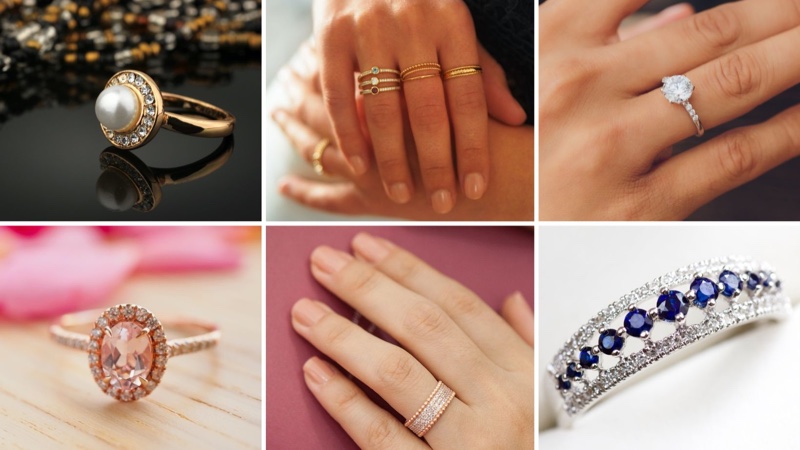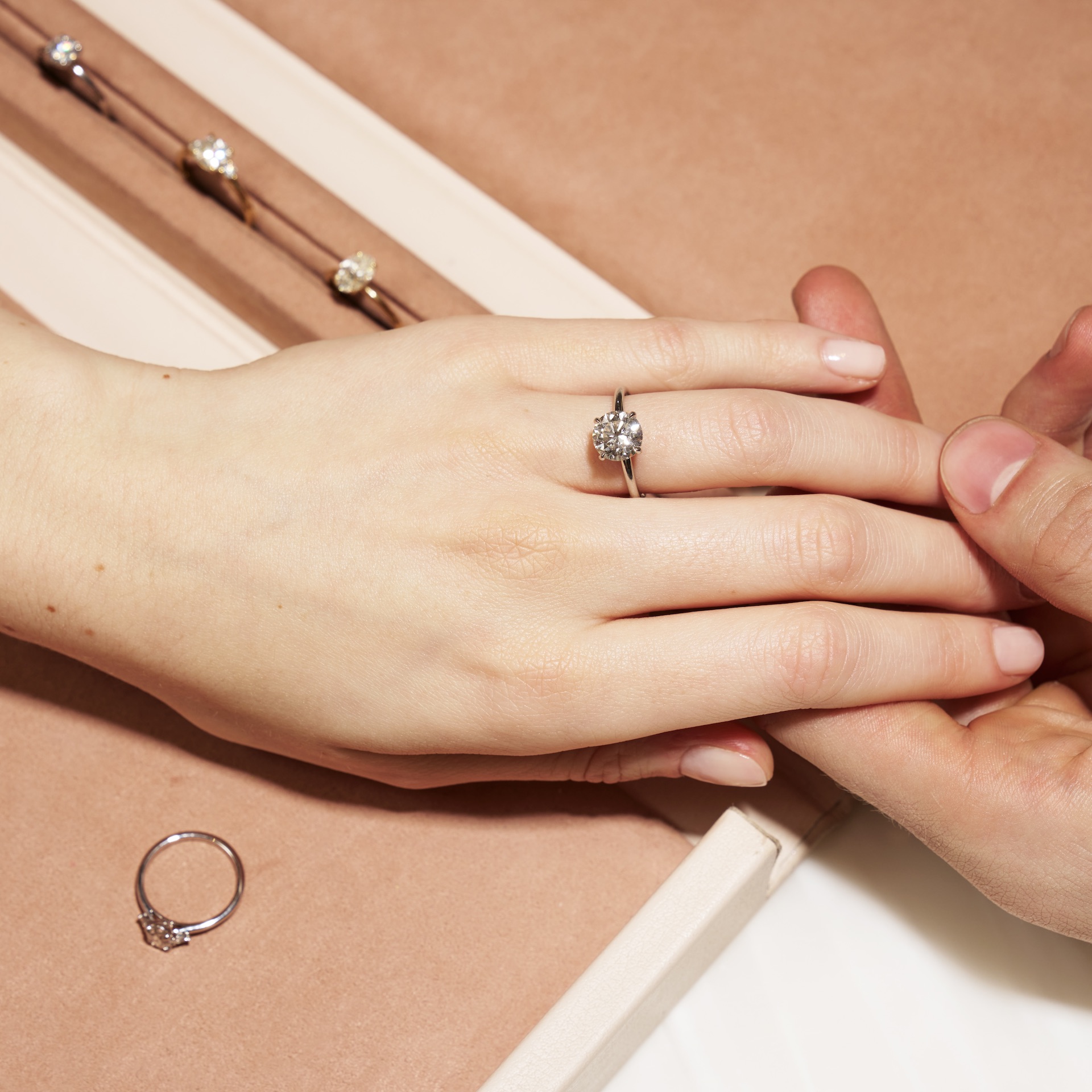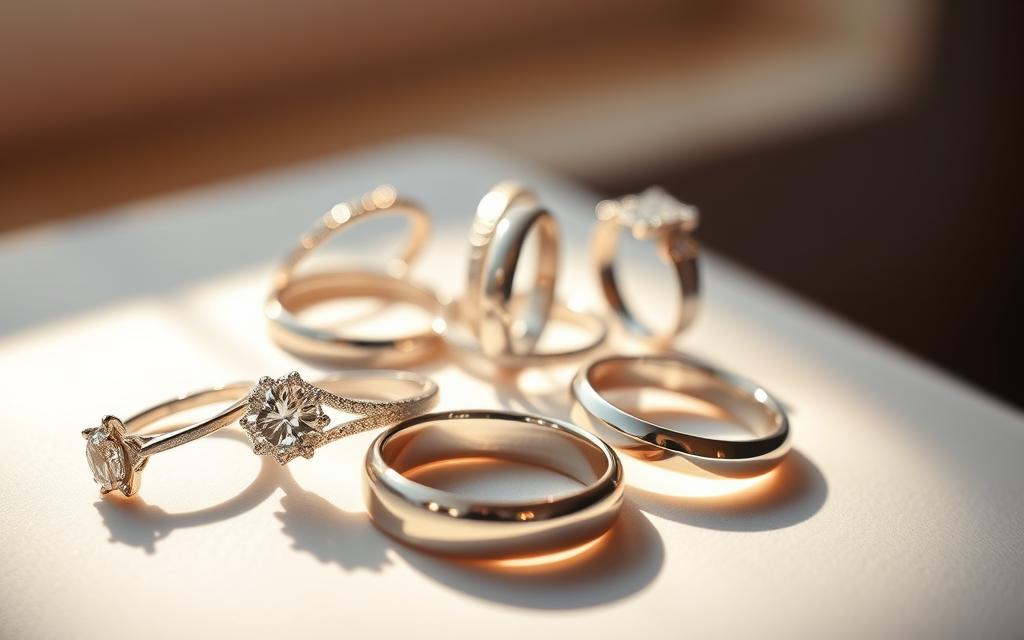Few pieces of jewelry embody timeless luxury and continuous symbolism quite like a gold ring adorned with diamonds encircling the entire band. This design, known most commonly as an eternity band or infinity ring, transcends fleeting trends to become a perennial statement of commitment, celebration, and unbroken beauty. More than just a ring, it’s a circle of light, a seamless embrace of precious metal and scintillating gems that captures the eye and resonates with profound meaning. This article delves deep into the world of the gold ring with diamonds all around, exploring its history, variations, craftsmanship, symbolism, and the compelling reasons why it remains an eternally coveted treasure.
1. Introduction: The Unbroken Circle of Brilliance
Imagine a band of warm, lustrous gold, its entire circumference meticulously set with a continuous line of sparkling diamonds. This is the essence of the “diamonds all around” ring. Unlike solitaires or three-stone rings that focus attention on a central point, this design offers brilliance from every angle. It speaks of totality, wholeness, and an unending flow of light and love. Whether worn alone as a bold statement or stacked with other rings, it commands attention with its understated yet undeniable opulence. It represents a commitment not just to a moment, but to a lifetime.
2. Defining the Design: Eternity Bands and Beyond
The term “eternity band” is most frequently used to describe a ring featuring a continuous circle of diamonds (or other gemstones) set around the entire shank (the band part of the ring). However, nuances exist:
- Full Eternity Band: This is the classic “diamonds all around” design. Diamonds are set continuously around the entire circumference of the band. This offers maximum sparkle and symmetry from every perspective. However, it typically cannot be resized easily (if at all) due to the continuous setting.
- Half Eternity Band: Diamonds are set only around the top half or the top three-quarters of the band. The bottom portion (the part facing the palm) is plain metal. This design still offers significant sparkle from the top and sides (the most visible angles) while allowing for resizing in the future and often being more comfortable against the finger.
- Three-Quarter Eternity Band: A compromise between full and half, offering diamonds set around a larger portion of the band than a half eternity but leaving a small plain metal section underneath for potential sizing and comfort.
- Channel Set Eternity Band: Diamonds are set within a continuous channel formed by two parallel walls of metal. This offers excellent security and a smooth, modern, seamless look where the diamonds appear to float within the band. The metal walls protect the diamonds’ girdles.
- Pavé Set Eternity Band: Small diamonds are set very close together using tiny beads or prongs of metal, creating a surface that appears almost entirely covered in diamonds (“paved”). This maximizes sparkle and creates a glittering, textured effect. Requires meticulous craftsmanship.
- Shared Prong Eternity Band: Diamonds are held in place by prongs that are shared between adjacent stones. This minimizes the metal visible between diamonds, maximizing the appearance of a continuous line of sparkle and allowing more light to enter the stones.
- Bead Set Eternity Band: Similar to pavé, but the metal beads holding the diamonds are slightly more pronounced, creating a subtle dotted texture along the band.
- Bar Set Eternity Band: Thin vertical bars of metal separate each diamond, offering a distinctive geometric look and excellent security.
3. A Legacy of Light: The History of the Eternity Band
The concept of an unbroken circle as a symbol of eternity dates back millennia, found in ancient Egyptian, Greek, and Roman cultures. The specific combination of this form with precious gems, however, has a more traceable lineage:
- Georgian Era (1714-1837): While not called “eternity bands,” rings featuring gemstones set around the entire circumference began to appear. Georgian jewelers often used rose-cut diamonds or colorful gemstones like garnets or sapphires, set in silver or gold. These were sometimes mourning rings or symbols of enduring affection.
- Victorian Era (1837-1901): Sentimental jewelry flourished. Rings featuring gemstone halos or clusters became popular, and the concept of gems encircling the finger gained traction, often symbolizing eternal love or remembrance. Snake rings (Ouroboros), swallowing their own tails, were a potent symbol of eternity during this period.
- Art Deco Era (1920s-1930s): This period saw a revolution in geometric design and a love for diamonds and platinum. Channel setting was perfected, paving the way (pun intended) for the sleek, continuous lines of the modern eternity band. The clean lines and emphasis on symmetry perfectly suited the eternity concept. Diamonds became the dominant stone.
- Mid-20th Century: The term “eternity ring” became firmly established, particularly in Britain, where it became traditional for a husband to gift his wife such a ring to commemorate a significant anniversary or the birth of a child, symbolizing enduring love through the years. The design solidified, often featuring full or half circles of brilliant-cut diamonds in yellow or white gold.
- Late 20th Century to Present: Eternity bands exploded in popularity globally. They evolved beyond strict anniversary gifts to become versatile fashion statements, wedding bands, and symbols of personal achievement. The range of styles, settings, metals, and diamond sizes expanded dramatically, catering to diverse tastes. The “diamonds all around” concept remains a pinnacle of continuous luxury.
4. The Foundation: Choosing the Gold
The warm embrace of gold forms the perfect canvas for diamonds. The choice of gold type significantly impacts the ring’s overall aesthetic:
- Yellow Gold: The classic choice. Its warm, rich hue provides a beautiful contrast to the white sparkle of diamonds, enhancing their fire. It radiates traditional luxury and timeless appeal. Available in various karats (purity levels):
- 14K Yellow Gold (58.3% pure gold): The most popular choice for eternity bands. Offers an excellent balance of rich color, durability, and affordability. Resists scratching and denting better than higher-karat options.
- 18K Yellow Gold (75% pure gold): Richer, deeper yellow color and a higher perceived value. Softer than 14K, making it slightly more prone to scratches but still very durable for rings. Offers a more luxurious feel.
- 22K Yellow Gold (91.7% pure gold): A very rich, deep yellow, almost orange hue. Significantly softer and less durable for everyday wear in a ring with diamonds all around, as it can bend or dent more easily. Less common for eternity bands.
- White Gold: Offers a cool, contemporary look that allows the diamonds to blend seamlessly or stand out brightly against the white metal. Created by alloying yellow gold with white metals like nickel, palladium, or silver, and then plated with rhodium (a platinum-group metal) for a bright white finish.
- 14K White Gold: Durable and popular. Requires periodic re-rhodium plating (every few years) to maintain its bright white luster, as the underlying alloy can show through as slightly yellowish over time.
- 18K White Gold: Contains more pure gold, so the underlying alloy color is slightly warmer/yellower than 14K. Still requires rhodium plating for a bright white finish. Softer than 14K.
- Rose Gold: Has surged in popularity for its romantic, warm pink hue. Achieved by alloying gold with a higher proportion of copper (and sometimes silver). Complements a wide range of skin tones and offers a unique, modern yet vintage feel.
- 14K Rose Gold: Offers a lovely pink hue, excellent durability, and affordability. The copper content makes it strong.
- 18K Rose Gold: A richer, more pronounced pink or red hue due to higher copper content relative to gold. Softer than 14K but still suitable for eternity bands. Color can vary significantly depending on the alloy mix.
- Platinum: While not gold, it’s a crucial alternative. A naturally white, extremely dense, durable, and hypoallergenic precious metal. It holds diamonds securely and develops a beautiful patina over time (which can be polished back to high shine if desired). Often considered the ultimate luxury metal for diamond settings, offering superior longevity and a subtle, heavy feel. Significantly more expensive than gold.
5. The Stars of the Show: Diamonds in Eternity Bands
The diamonds are the source of the ring’s captivating sparkle. Choosing them requires specific considerations:
- Size and Carat Weight (Total Carat Weight – TCW): Eternity bands feature numerous smaller diamonds. Size is typically measured in points (1 point = 0.01 carat). Common sizes range from 0.01ct (1pt) per stone up to 0.10ct (10pt) or larger for more substantial bands. The Total Carat Weight (TCW) is the combined weight of all diamonds on the ring. This significantly impacts price and visual impact.
- Cut: The most critical factor for sparkle, especially in small stones. Brilliant cuts (like Round Brilliant) are overwhelmingly popular for eternity bands because they maximize light return, fire, and scintillation – the tiny flashes of light that create the “dance” of diamonds. Princess cuts are also common for their geometric sparkle. Excellent or Very Good cut grades are essential for maximum brilliance. Poorly cut diamonds will look dull and lifeless.
- Color: For a seamless look, especially in white gold or platinum, diamonds should be in the Near Colorless range (G-H-I-J). In these small sizes, slight tints are less noticeable than in larger stones, making this range offer excellent value. For yellow or rose gold, slightly warmer diamonds (K-L) can sometimes blend beautifully and cost less, as the metal color masks slight yellow tints. Consistency across all stones is key.
- Clarity: Small diamonds naturally hide inclusions better than large ones. SI1-SI2 (Slightly Included) clarity is often the sweet spot for eternity bands. Inclusions are typically invisible to the naked eye in stones under 0.05ct, offering significant savings without sacrificing visible beauty. VS2-VS1 (Very Slightly Included) offers more assurance of eye-cleanliness, especially in slightly larger stones. I1 (Included) diamonds might show visible flaws even in small sizes and are generally avoided. Consistency is again important.
- Setting and Security: The setting must hold these numerous small diamonds securely for a lifetime of wear. Channel, bezel, and shared prong settings generally offer the best security, protecting the diamonds’ girdles and points. Pavé and bead settings require expert craftsmanship to ensure stones are not easily dislodged. The quality of the setting is paramount.

6. The Art of Craftsmanship: Creating Perfection
Creating a high-quality gold ring with diamonds all around is a feat of precision and skill:
- Design and Pattern: The jeweler determines the style (full/half/three-quarter eternity), setting type, metal, diamond size, and any specific pattern (e.g., alternating sizes, mixed cuts). CAD (Computer-Aided Design) is often used for precision modeling.
- Metalworking: The band is formed, shaped, and meticulously finished. For full eternity bands, achieving a perfect circle with consistent thickness is crucial.
- Setting Preparation: For channel or bezel settings, the channel walls or bezel seats are carefully milled into the band with exacting tolerances to hold the diamonds perfectly. For prong or pavé settings, the positions are marked, and tiny seats are created.
- Diamond Selection and Calibration: Diamonds are carefully selected to match in size, color, and clarity. They must be precisely calibrated (cut to exact dimensions) to fit perfectly within the chosen setting pattern and sit flush with each other and the metal. This is especially critical for channel and shared prong settings.
- Setting: This is the most demanding phase. Each tiny diamond is painstakingly placed into its seat. For prong settings, delicate prongs are pushed over the diamond’s crown and shaped. For pavé or bead settings, tiny beads of metal are raised to hold the stones. For channel settings, the metal walls are gently pressed over the diamond’s girdle. Laser welding is sometimes used for added security in intricate settings. This requires immense patience, steady hands, and magnification.
- Finishing and Polishing: The set ring undergoes multiple stages of polishing to achieve a flawless, high-luster finish on the metal and to ensure no scratches or tool marks remain. Any residual polishing compound is meticulously cleaned away.
- Quality Control: The ring is rigorously inspected under magnification. Every diamond is checked for security and alignment. The overall finish, symmetry, and polish are evaluated. The ring is tested for comfort and structural integrity.
7. Styles and Variations: Beyond the Classic Band
While the continuous line is the hallmark, variations abound:
- Classic Single Row: A single line of identically sized diamonds in a consistent setting (e.g., all channel-set rounds).
- Multi-Row Bands: Two or more parallel rows of diamonds, creating a wider, more substantial band with increased sparkle and TCW.
- Alternating Cuts/Shapes: Mixing round brilliants with princess cuts, or adding baguettes or other fancy shapes for visual interest (e.g., round-princess-round-princess).
- Graduated Diamonds: Diamonds that subtly increase in size towards the center top of the band.
- Milgrain Detailing: Adding tiny beaded edges along the metal for a vintage, softened look.
- Twisted or Rope Bands: Incorporating a twisted or rope-like design into the metal, with diamonds set along the high points.
- Bypass or Open Bands: Designs where the band appears to twist or cross over itself, with diamonds set along the overlapping sections.
- Gemstone Accents: Incorporating small colored gemstones (like sapphires or rubies) sparingly within the diamond circle for a pop of color or personalization.
- Texture Contrast: Combining polished diamonds with a brushed or hammered finish on the gold itself.
8. Symbolism and Significance: More Than Just Sparkle
The “diamonds all around” ring carries deep and multifaceted symbolism:
- Eternal Love and Commitment: This is its primary meaning, especially as a wedding band or anniversary ring. The unbroken circle of diamonds represents love that has no beginning and no end – infinite and everlasting. It signifies a bond that endures through all of life’s seasons.
- Celebration of Milestones: Traditionally gifted for significant anniversaries (especially the 10th, 25th, 40th, 50th) or to commemorate the birth of children, symbolizing the enduring nature of family and shared life.
- Achievement and Self-Love: Increasingly popular as a gift to oneself, celebrating personal milestones, career success, or simply as an expression of self-worth and enduring spirit. It says, “I am complete, I am strong, I endure.”
- Continuity and Wholeness: The circle is a universal symbol of wholeness, unity, and the cyclical nature of life. The diamonds add the element of enduring light, clarity, and purity.
- Protection and Strength: Historically, the circle was seen as protective. The enduring strength of gold and diamonds reinforces this symbolism – a talisman of resilience.
- Uninterrupted Beauty: It represents constant beauty and radiance, visible from every perspective.
9. Choosing Your Perfect Circle: A Buyer’s Guide
Selecting a gold ring with diamonds all around requires careful consideration:
- Purpose: Is it an anniversary gift, a wedding band, a right-hand ring, or a personal achievement marker? This influences style and budget.
- Full, Half, or Three-Quarter Eternity? Consider comfort, sizing flexibility (full eternity generally can’t be sized easily), and desired sparkle level. Half or three-quarter are practical and popular choices.
- Metal Choice: Yellow, White, or Rose Gold? Platinum? Consider skin tone, personal style, existing jewelry, and budget (platinum is premium).
- Setting Style: Channel (secure, smooth), Pavé (max sparkle), Shared Prong (minimal metal), Bezel (modern, protective)? Consider lifestyle and potential snagging.
- Diamond Quality Focus:
- Cut: Prioritize Excellent/Very Good. Sparkle is paramount.
- Color: Near Colorless (G-J) for white metals; K-L can work in yellow/rose gold. Ensure consistency.
- Clarity: SI1-SI2 is typically sufficient for eye-cleanliness in small stones. VS offers more assurance. Consistency matters.
- Carat Weight (TCW): Determine the visual impact and budget you desire. Size per stone and number of stones determine TCW.
- Certification: For significant investments, request a detailed specification sheet or grading reports (e.g., IGI often certifies melee parcels) confirming quality parameters.
- Band Width and Profile: Wider bands make a bolder statement; narrower bands are more delicate. Consider comfort and how it will stack or fit with other rings. Low-profile settings are often more comfortable.
- Comfort Fit: Many bands have a slightly rounded interior profile (“comfort fit”) instead of a flat one, making them more comfortable for all-day wear, especially important for eternity bands.
- Budget: Prices vary enormously based on metal, TCW, diamond quality, brand, and craftsmanship. Set a realistic range.
- Reputable Jeweler: Purchase from a trusted jeweler known for quality and ethical sourcing. Examine craftsmanship closely (stone security, setting alignment, polish). Ask about warranties, maintenance (e.g., re-tipping prongs, re-rhodium plating for white gold), and sizing policies (especially for full eternity).

10. Caring for Your Circle of Light: Preservation
A gold eternity band is designed for a lifetime, but it requires care:
- Regular Cleaning: Clean gently at home using a soft toothbrush, lukewarm water, and a few drops of mild dish soap. Rinse thoroughly and dry completely with a soft cloth. Avoid harsh chemicals (bleach, chlorine, acetone) and ultrasonic cleaners (can loosen stones, especially in pavé).
- Professional Maintenance: Have the ring inspected by a jeweler every 6-12 months. They will check for loose stones, worn prongs/bezel edges, and overall condition. Professional cleaning restores brilliance.
- Safe Storage: Store separately in a soft-lined jewelry box, ideally in its own compartment. Avoid contact with harder jewelry to prevent scratches.
